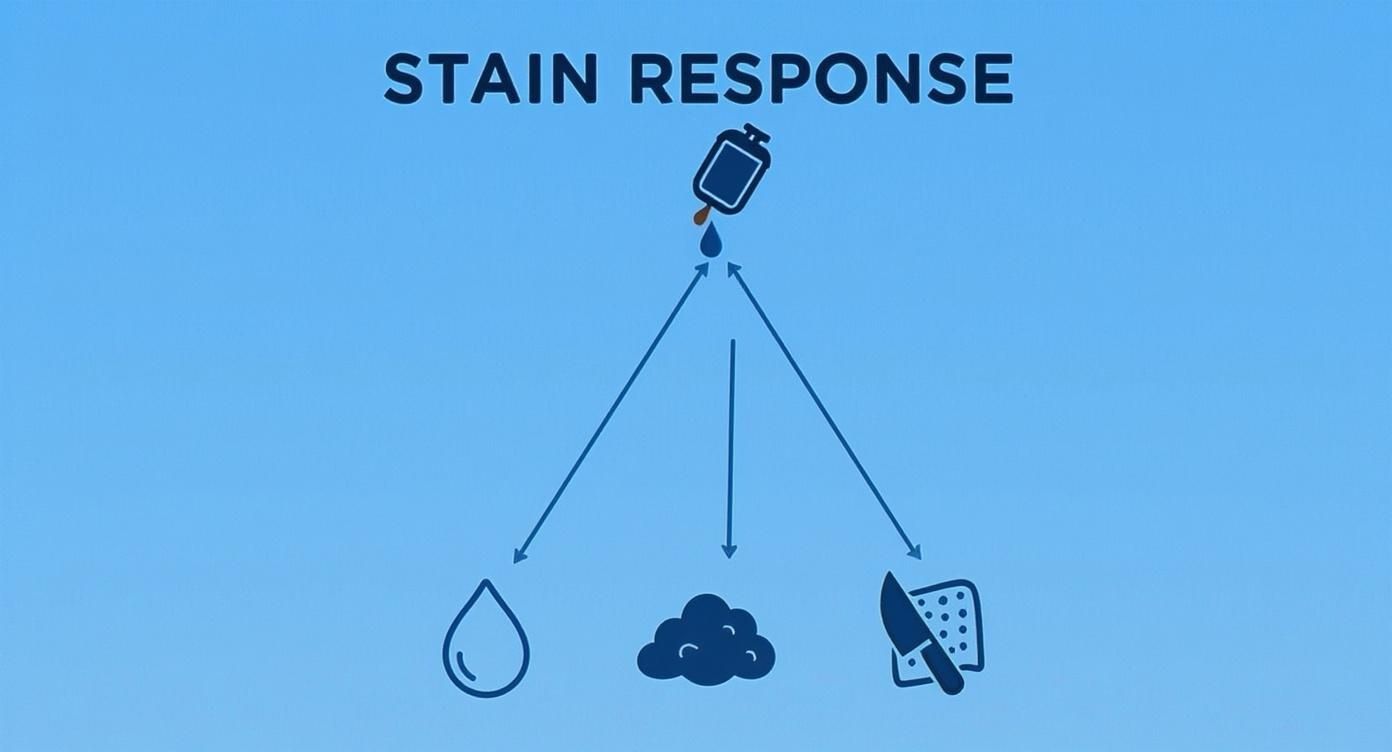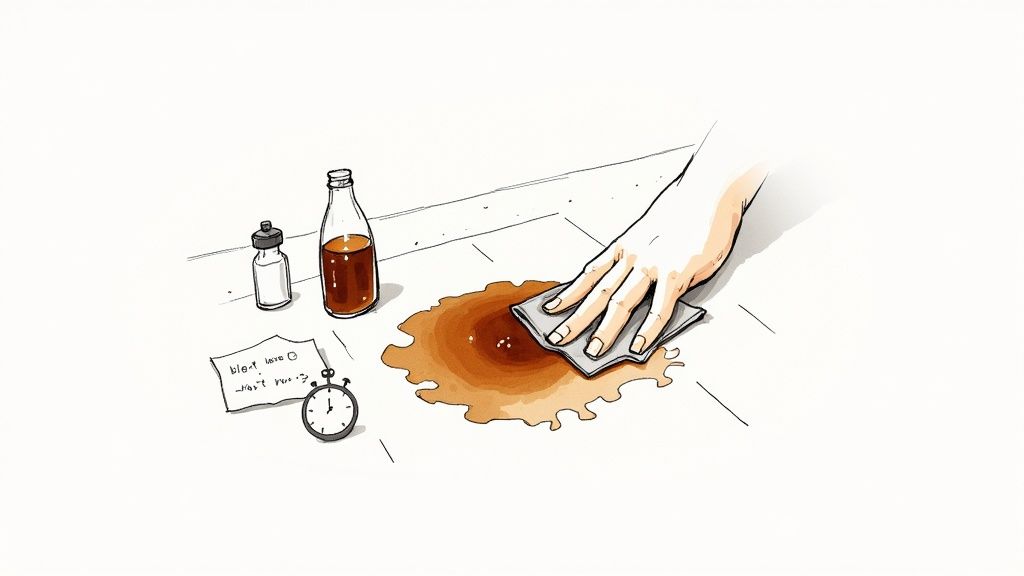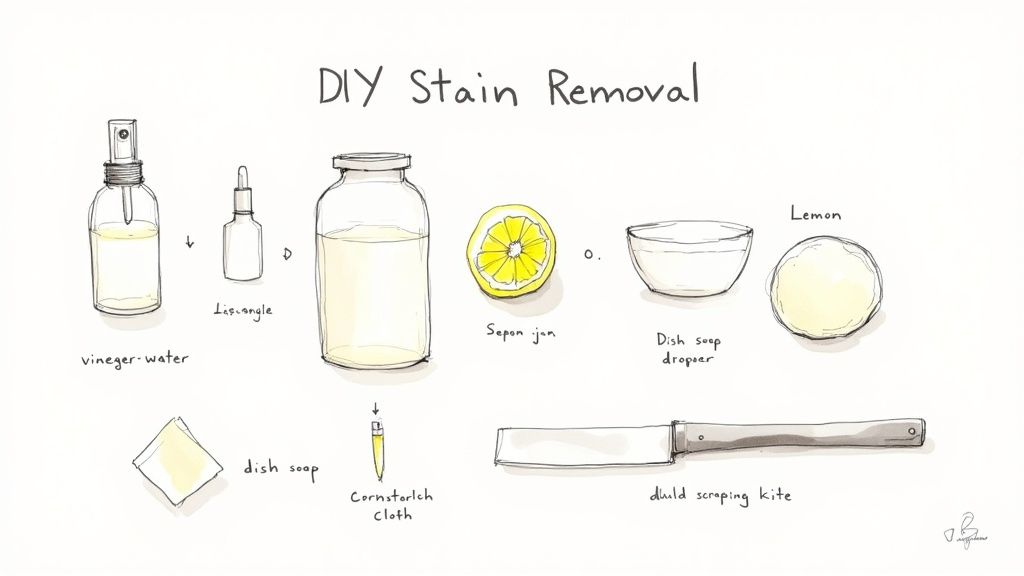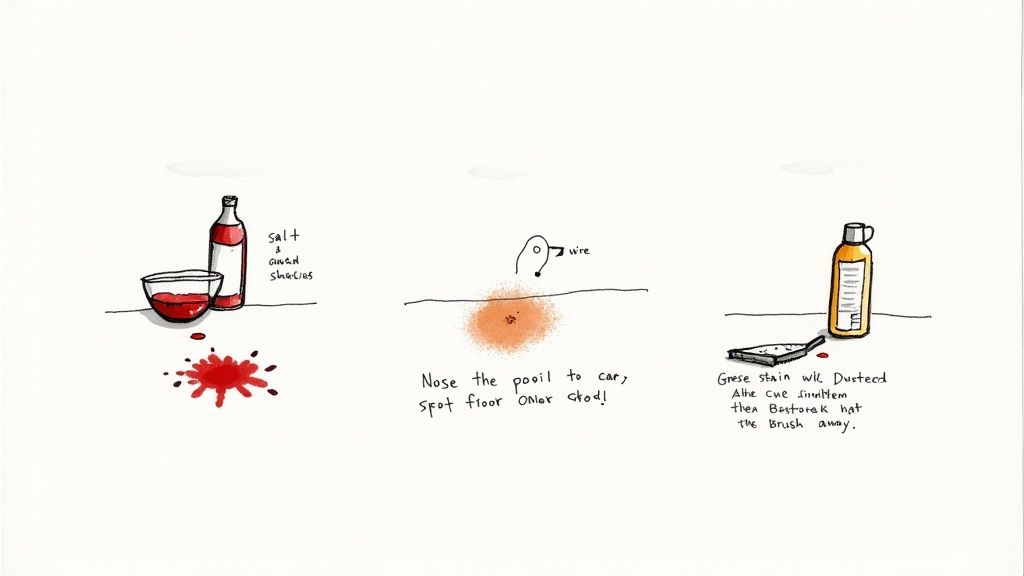When it comes to tough carpet stains, your success hinges on one thing: acting fast with the right technique. The golden rule, and I can't stress this enough, is to blot gently with a clean cloth. Always work from the outside edge of the spill inward. This stops the stain from spreading.
Whatever you do, don't rub. I've seen it a hundred times—scrubbing and rubbing only grinds the stain deeper into the carpet fibers, making a temporary problem a permanent one.
Your Immediate Response Plan for Any Carpet Spill
That moment when a glass of wine tips over or the dog tracks in mud is a critical window of opportunity. The natural instinct is to panic and start scrubbing, but that's the absolute worst thing you can do. Instead of pushing the mess deeper, a calm, quick response can make all the difference. In those first few minutes, your job is damage control, not a full-on deep clean.
How you handle those first moments often determines whether you'll be looking at that spot for years to come. Different spills need different kinds of first aid. A liquid spill needs to be absorbed immediately, while something thick like mud is best left to dry so you can scrape it away first.
Act Fast, The Right Way
Knowing what to do is half the battle. This simple decision tree shows the correct first step for the two main types of carpet spills you'll encounter.

As you can see, your first move—blotting liquids versus scraping solids—is all about preventing a small accident from becoming a major headache.
This is why almost every household has a bottle of spot remover under the sink. It's a massive industry, valued at USD 1.3 billion in 2025 and still growing. This demand just proves how common these accidents are; in fact, over 70% of households with carpet rely on spot removers to deal with messes.
Immediate Stain Response Guide
Before you even reach for a commercial cleaner, a few common household items can save the day. Here's a quick-reference guide for what to grab in those first critical seconds.
| Stain Type | Immediate Action | Household Item to Use |
|---|---|---|
| Red Wine | Blot, then pour on a thick layer to absorb. | Clean cloth, then generous amount of Salt |
| Coffee/Tea | Blot thoroughly. | Club Soda or a damp, clean cloth |
| Mud | Let it dry completely, then scrape and vacuum. | Dull Knife or spoon |
| Grease/Oil | Scrape excess, then sprinkle to absorb oil. | Spoon, then Baking Soda or Cornstarch |
| Pet Urine | Blot with heavy pressure to absorb as much as possible. | Thick stack of paper towels or a microfiber cloth |
This table covers the essentials for immediate action, which is often all you need to prevent a stain from setting.
Common Household First Responders
You don't always need a specialized product right away. Several common items can be your first line of defense against a fresh spill.
- Club Soda: The carbonation is brilliant for lifting fresh spills like red wine or coffee right out of the fibers.
- Salt: When you pour it liberally over a new wine spill, the salt literally wicks the liquid up and out of the carpet pile. Let it sit, then vacuum it up.
- A Dull Knife or Spoon: Perfect for scraping away gunk like mud, dropped food, or even candle wax without snagging or damaging your carpet loops.
Remember, the single most important rule is to blot, never rub. Blotting lifts the stain out; rubbing grinds it further in and can permanently damage the carpet fibers.
For a complete breakdown of what to do in those crucial first moments, you can find more details in our guide on the best way to get spots out of carpet.
Keeping up with proactive cleaning is also key to a healthy home. Incorporating general upkeep, like these spring cleaning maintenance tips for property owners, helps you manage and prevent common messes before they turn into major problems.
Building Your DIY Stain Removal Toolkit
Forget wandering down the cleaning aisle, staring at a wall of expensive, chemical-heavy products. The best weapons you have in the war against carpet stains are probably sitting in your kitchen pantry right now.
Putting together your own DIY stain removal kit is a game-changer. It's not just cheaper; it gives you powerful, non-toxic options that you know are safe around your family and pets. With just a few simple ingredients, you can handle almost anything life throws at your floors.
When a glass of red wine tips over, the last thing you want is to be frantically digging through cabinets. Having a small, dedicated kit ready to go means you can act fast. And when it comes to stains, speed is everything. It's the difference between a minor cleanup and a permanent eyesore.

Your Essential DIY Cleaning Solutions
These three homemade cleaners are the backbone of my stain-fighting arsenal. They're incredibly easy to mix, gentle on most carpets I've worked on, and you'll be surprised at how well they perform.
-
The All-Purpose Vinegar Spray: This one's the real workhorse. Just mix a solution of 50% white vinegar and 50% water in a spray bottle. The acetic acid in vinegar is a powerhouse, breaking down a huge range of common stains from coffee spills to muddy paw prints.
-
The Grease-Lifting Baking Soda Paste: For those greasy, oily stains from a dropped piece of pizza or a splash of salad dressing, this is your go-to. Mix baking soda with a tiny bit of water until you have a thick paste, almost like toothpaste. It does a fantastic job of absorbing and pulling the grease right out of the carpet fibers.
-
The Gentle Dish Soap Mix: When you're dealing with food-based accidents or just general grime, keep it simple. Add about one teaspoon of clear, mild dish soap to a cup of warm water. Just be sure to avoid any soaps that have bleach or lanolin in them—they can cause damage or leave behind a sticky residue that attracts more dirt.
Pro Tip: Have a light-colored carpet? A bit of lemon juice mixed with water can act as a natural brightener on some stains. But always test it on a hidden spot first, like inside a closet. That acidity can sometimes lighten certain carpet dyes.
Must-Have Tools for The Job
Having the right cleaners is only half the story. You need the right tools to apply them without making the mess worse. Don't even think about tackling a stain without these on hand.
- Microfiber Cloths: Get a small stack of clean, white microfiber cloths. Their absorbency is unmatched for blotting up spills, and using white ones ensures you won't accidentally transfer any color onto your carpet.
- A Dull Knife or Spoon: This is your first line of defense against solid messes like candle wax, thick mud, or globs of food. You need to scrape up the excess before you start treating the stain.
- A Dedicated Spray Bottle: Keep that vinegar and water mix pre-made and labeled. Trust me, you'll thank yourself later when you can just grab it and go.
- Vacuum Cleaner: This is a non-negotiable final step. After a baking soda paste or salt treatment has dried and done its job absorbing the stain, you need a good vacuum to clean it all up properly.
With these simple items in your kit, you'll be ready to handle the vast majority of household carpet stains like a pro.
Proven Methods for Conquering Stubborn Stains

Some spills are just plain scary. A bit of tracked-in dirt is one thing, but a splash of red wine or a greasy food mishap feels like a code-red emergency for your carpet. These are the stains that test your patience.
But don’t panic. With the right game plan, even the most notorious culprits can be beaten.
We’re moving beyond general advice and diving into specific battle plans for three of the toughest messes you’ll face: vibrant red wine, pungent pet urine, and slippery grease. Each one needs a unique approach that targets its specific chemistry.
Tackling Red Wine Spills
The sight of red wine soaking into a light-colored carpet is enough to make your heart stop. The absolute key is to act immediately to lift those intensely pigmented tannins before they permanently dye the fibers.
After blotting up as much as you can, head to your kitchen pantry. Liberally pour salt directly onto the stain. It sounds strange, but the salt crystals act like tiny sponges, drawing the wine up and out of the carpet through osmosis. Let it sit until it turns pink—you can literally see it working. Once it's dry, scrape away the salt and vacuum it up.
If a faint shadow remains, grab some club soda. The carbonation helps lift the last traces of the stain from the fibers. Gently blot with a cloth dampened with club soda until it’s gone.
Neutralizing Pet Urine Stains
Pet urine is a double-whammy: it's both a stain and a source of persistent, awful odor. Simply cleaning the visible spot isn't enough. The uric acid crystals left behind are what create that lingering ammonia smell and, worse, encourage your pet to mark the same spot again.
Your real goal is to neutralize the stain and the odor-causing bacteria. After blotting the area with heavy pressure to absorb as much liquid as possible, a 50/50 solution of white vinegar and water is your best friend. The acid in the vinegar works to break down the uric acid.
For persistent pet odors, a specialized cleaner is often necessary. The most effective options are enzymatic cleaners, which contain beneficial bacteria that literally digest the organic matter in the urine, completely eliminating the source of the smell.
Learning what an enzymatic cleaner is can be a total game-changer for pet owners. And it's a huge issue—with over 65% of U.S. households now owning a pet, the demand for effective stain removers has skyrocketed. These pet-related problems are notoriously difficult and drive a huge part of the cleaning market, as this carpet stain remover market report shows.
Defeating Grease and Oil Stains
Greasy stains from things like pizza, butter, or salad dressing won't come out with water alone. In fact, water can spread the oil and make it worse. Your first move is always absorption.
Scrape away any solid bits, then generously sprinkle cornstarch or baking soda over the entire stain. Let the powder sit for at least 15-20 minutes (or even a few hours for bigger spills). It will absorb the oil, pulling it right out of the carpet fibers. You’ll actually see the powder start to clump as it works.
After the powder has done its job, vacuum it up thoroughly. Now you can treat what’s left. A few drops of a clear, grease-cutting dish soap mixed in warm water is perfect. Dab the solution onto the spot, blot with a clean cloth, and repeat until the greasy feel is gone. Finish by blotting with a water-dampened cloth to rinse away any soap residue.
Tough Stain Treatment Comparison
To make it even easier, here's a quick cheat sheet for tackling these common carpet emergencies. Sometimes a DIY approach is all you need, but knowing when to grab a store-bought product can save your carpet.
| Stain Type | Recommended DIY Solution | When to Use a Commercial Product | Key Tip |
|---|---|---|---|
| Red Wine | Salt to absorb, then club soda to lift the remainder. | If the stain has set or a pink hue remains after DIY treatment. | Act fast! The longer it sits, the harder it is to remove. |
| Pet Urine | 50/50 white vinegar and water solution to neutralize uric acid. | For set-in stains or persistent odors that keep coming back. | Always use an enzymatic cleaner for odor to truly eliminate it. |
| Grease/Oil | Cornstarch or baking soda to absorb, then diluted dish soap. | If the stain is large, old, or from a synthetic oil (like motor oil). | Never use hot water, as it can set the grease stain permanently. |
Remember, these are powerful tools for your cleaning arsenal. With the right technique, you can confidently face down even the most intimidating carpet stains.
Advanced Tricks for Old and Mystery Stains
What about those stains you don't see happen? You know the ones. You turn a corner and suddenly spot a dark, mysterious splotch that definitely wasn't there yesterday. Or worse, one that’s been hiding under the sofa for who-knows-how-long. This is where your standard cleaning methods for fresh spills just won't cut it.
Don't give up on these set-in problems, though. With a little detective work and a couple of clever techniques, you can tackle even the most stubborn and unidentified stains. It takes a different, more patient approach, but the results are often surprisingly good.

The Freeze-Fracture Method for Gummy Messes
Ever dealt with chewing gum, sticky candy, or hardened wax on your carpet? It's a nightmare. Trying to scrape these messes off at room temperature usually creates a smeared, gooey disaster that only works its way deeper into the fibers. The real trick here is to change the texture from sticky to brittle.
Grab a few ice cubes and hold them directly on the gum or wax for several minutes. You're trying to freeze it solid. Once it’s hard and brittle, you can use a dull knife or the edge of a spoon to carefully fracture and chip the pieces away. It’s a clean way to remove the bulk of the mess without smearing it everywhere.
Using Heat to Reactivate Certain Stains
For some older, non-greasy stains (like a faint coffee ring or a dried juice spill), a little heat can work wonders to reactivate and lift them. This technique requires extreme caution and should never be used on synthetic carpets like nylon or polyester—you'll melt the fibers. It's only safe for natural fiber carpets like wool or cotton.
If you have a natural fiber carpet, here's the game plan:
- Lightly dampen a clean, white cloth with water.
- Place the damp cloth right over the old stain.
- Set a household iron to a low, no-steam setting.
- Press the iron onto the cloth for just a few seconds at a time. The heat creates steam, which helps pull the stain from the carpet fibers up into the cloth.
Keep checking the cloth. You should start to see the stain transferring over to it.
Safety First: Always test this method on a hidden spot of your carpet first to make sure it doesn't cause damage or discoloration. If your carpet is synthetic, skip this method entirely. Seriously.
Solving the Mystery Stain
When you have absolutely no idea what caused a stain, the key is to work from the gentlest solution upwards. Don't go nuclear right away.
Start with plain cold water and blot. If that doesn't work, move on to your diluted vinegar solution. Still there? Try a small amount of diluted clear dish soap. After each attempt, make sure you gently rinse with water and blot the area completely dry to remove the cleaning agent before trying the next thing. This methodical process helps you solve the mystery without overwhelming the carpet fibers with a cocktail of harsh chemicals.
Knowing When to Call a Professional
The DIY methods we’ve covered are fantastic for most everyday spills, but there are times when trying to be a hero can do more harm than good. It’s a tough pill to swallow, but knowing the limits of your home remedies is the key to protecting your carpet from permanent damage.
Frankly, some jobs are just best left to people with the right gear and training.
A small food spill is one thing, but a massive ink or paint spill can turn into a homeowner's nightmare fast if you don't know exactly what you're doing. Using the wrong solvent can spread the stain like wildfire or, even worse, dissolve the carpet fibers themselves. You could turn a fixable problem into a very costly replacement.
Signs You Need to Make the Call
Sometimes, the writing is on the wall. Certain situations should be an immediate red flag that it’s time to pick up the phone and call in the cavalry. If you’re facing any of these, don't hesitate.
- Your Carpet's Material is Delicate: If you have wool, silk, or other natural fibers, you have to be incredibly careful. These materials are extremely sensitive to the pH levels in common cleaners like vinegar. A pro will know the precise chemistry needed to treat the stain without ruining your beautiful (and expensive) textile.
- The Stain is Huge or Deeply Set: Has a stain been sitting there for months—or maybe even years? It has likely bonded with the carpet fibers deep down where you can't reach it. Home methods might only clean the surface, leaving a stubborn shadow that keeps reappearing. For stains that are deeply set or cover a large area, it may be time to consider professional deep cleaning services.
- You're Dealing with Hazardous Materials: Any stain involving biological waste, harsh chemicals, or large amounts of mold isn't just a cleaning issue; it's a safety issue. These situations require specialized handling and safety protocols that go way beyond simple spot cleaning.
Ultimately, the decision comes down to weighing risk versus reward. If the potential cost of permanently damaging your carpet is high, investing in a professional cleaning is the smarter, safer bet every single time.
Choosing the Right Professional
When you decide it's time to hire a service, a little bit of homework goes a long way. The stain remover market is massive—projected to hit USD 28.84 billion by 2035—which means there are countless companies out there to choose from. A lot of this growth is being driven by people like you demanding safer, more eco-friendly cleaning solutions.
So, when you're vetting a company, ask specific questions. Don't be shy!
Find out what their primary cleaning method is (steam cleaning vs. low-moisture, for example) and what kind of solutions they use. This is especially important if you have pets or small children. A reputable company will be totally transparent about their process and pricing.
A great pro won't just clean the stain; they can also give you solid advice on how to clean heavily soiled carpets in the future, offering preventative tips to make your life easier.
Got Questions About Carpet Stains? We've Got Answers.
When you're on your hands and knees trying to tackle a stubborn carpet stain, questions are bound to pop up. It’s totally normal to wonder if that cleaning hack you saw online is actually safe or if you're about to make things a whole lot worse. I've heard just about every question in the book, so I've gathered the most common ones right here to give you some clear, practical answers.
Getting this stuff right can be the difference between a successful cleanup and accidentally creating a permanent, discolored patch on your floor. It's all about knowing what to do—and what not to do.
Can I Use Bleach on My Carpet?
Let's get this one out of the way first: using household bleach on your carpet is a massive gamble, and one you'll almost always lose. Most carpets in homes are made from synthetic fibers like nylon or polyester. Chlorine bleach will literally strip the color right out of them, leaving a glaring, permanent blotch. Even worse, it can eat away at the fibers themselves, weakening them to the point of disintegration.
Now, there's a tiny exception for some solution-dyed carpets you might find in a commercial building, which are made to be colorfast. But unless you are 100% certain what your carpet is made of and that it's bleach-safe, don't even think about it. An oxygen-based cleaner designed for carpets is a much, much safer bet.
Is Vinegar Going to Wreck My Carpet?
White vinegar is a fantastic tool in the DIY cleaning arsenal, but it's not a magic bullet for every situation. For the vast majority of synthetic carpets, a diluted solution—usually a 50/50 mix with water—is perfectly safe. The acidity is great for breaking down a lot of common household stains without harming the fibers.
Where you have to be careful is with natural fiber carpets, like wool or silk. These are much more delicate. The acid in vinegar can damage these fibers over time or cause their dyes to bleed. It's not a risk worth taking.
Here’s a pro tip I give to everyone: Always test any cleaning solution first, even something as simple as vinegar. Find a hidden spot, like inside a closet or under a big piece of furniture, and apply a tiny amount. Let it sit, blot it up, and see if there’s any color change. This one simple step can save you from a major headache.
After you've treated a stain with your vinegar mix, it's smart to gently "rinse" the spot. Just dampen a clean cloth with plain water and blot the area. This helps get rid of any lingering acidity and prevents any residue from attracting dirt later on.
How Can I Keep Stains From Happening in the First Place?
Honestly, the best way to deal with a tough stain is to prevent it from ever setting in. A little proactive thinking will save you a ton of scrubbing down the road. Here are a few simple strategies that really work:
- Get a Carpet Protectant: Think of this as an invisible shield for your carpet. A professionally applied stain-resistant finish causes liquids to bead up on the surface instead of instantly soaking in. That gives you precious extra seconds to grab a cloth and clean it up.
- Institute a "No-Shoes" Rule: It sounds simple, but it's incredibly effective. Making everyone take their shoes off at the door drastically reduces the amount of dirt, oils, and general grime that gets tracked across your floors.
- Use Area Rugs Strategically: Put down runners and area rugs in high-traffic zones like entryways, hallways, and especially under the dining table. They'll take the abuse, and they're a whole lot easier to clean (or replace) than your wall-to-wall carpeting.
- Keep Your Cleaning Kit Handy: Don't bury your supplies in the back of a cabinet. Keep your clean cloths, vinegar spray, and baking soda somewhere you can grab them in a hurry. When it comes to spills, a fast response is your best defense against a permanent stain.
For those deep-set stains or jobs that just feel too big to handle, sometimes you have to call in the professionals. At Citrus Carpet Cleaning Buford, we use a low-moisture, citrus-based system that gets deep into the fibers without leaving behind the sticky, soap-based residues that cause carpets to get dirty again fast. Get your transparent, upfront "EXACT-imate" today by visiting us at https://citruscarpetcleaningatlanta.com.

